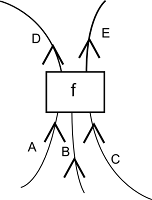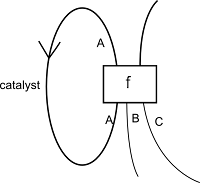
Specifically, I wanted to use these diagrams to think about various things like :
- Factories
- Economies
- Chemical reaction networks
Then I started thinking about chemical processes and I wondered if you can bend a wired around back and attach it to the input of a box. That is something you definitely do in the diagrammatic calculus.

I then realized by looking at the diagram that what I had invented was the catalyst, in an abstract sense. This means that catalysts, when seen in networks of chemical processes are actually traces in the category. This also kind of indicates that chemical process networks should be modeled as these kinds of diagrams. But then this only makes sense since chemical reactions are exactly maps in the category of Hilbert spaces and the axioms of this category are equivalent to the rewrite axioms of these diagrams.
Looking around online for anything written about this, I didn't find anything so I wrote about it here. What I did find was the concept of autocatalysis. This is where the product of a process is its own catalyst and that diagram is demonstrated here:

We see that there is no output except the catalyst. This means that the process itself is simply there to encourage more of itself. Some say that this has something to do with life itself. The metaphor would be something like: life is a process that simply makes stuff that increases the likelihood of that process happening again.
I am wondering if diagrams like this exist in Coecke's diagrammatic calculus and I think they must.